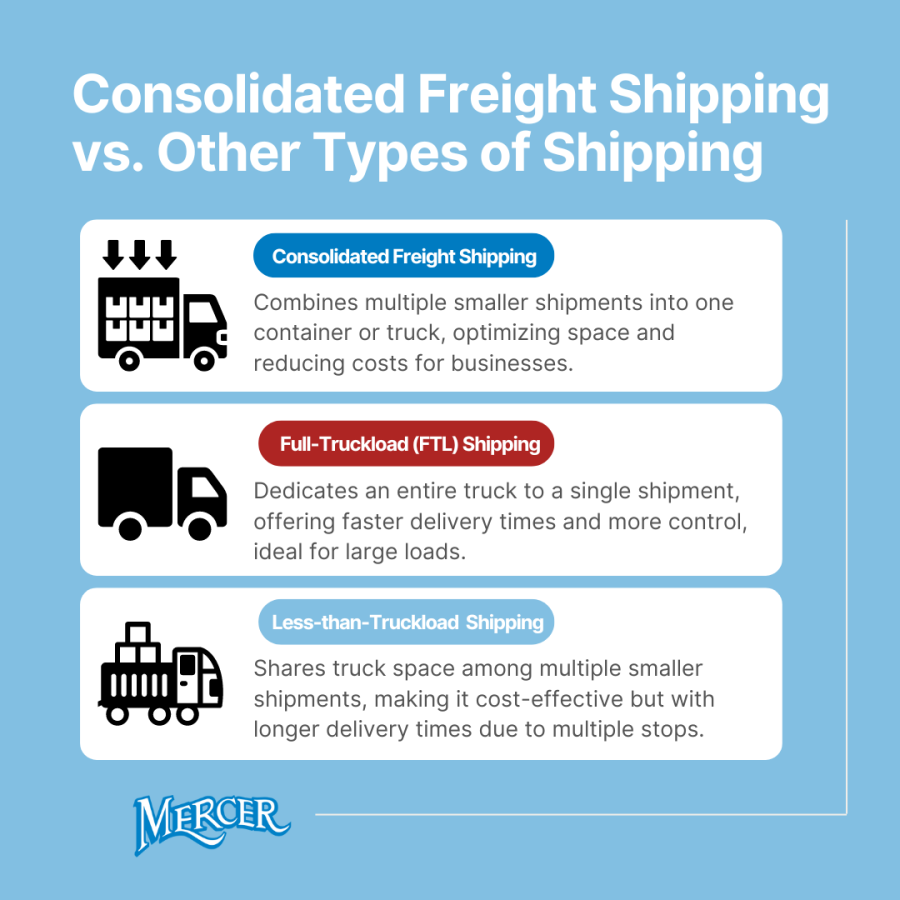Cheapest Shipping from China to the US: Consolidated Freight vs. Standard Services
Introduction
Importing from China to the US offers immense opportunity—but shipping choices can make or break your margins. For businesses and individuals in Europe and North America, efficiently moving goods across continents requires balancing cost, timing, and reliability. In this comprehensive guide, we unpack the most cost-effective shipping methods, spotlight consolidated freight, and compare it with standard options like FCL, LCL, air freight, and courier services.

1. Overview of Shipping Options
1.1 Sea Freight (FCL vs. LCL)
- FCL (Full Container Load): Ideal for high-volume imports with exclusive container use. Estimated cost: $2,000–$3,500 per 20-ft container, depending on ports and season. Transit time: ~15–35 days. 森林货运Easy Imex华尔街日报
- LCL (Less-than-Container Load): Cost-effective for smaller volumes but involves shared containers and added handling. Rates: $60–$105 per CBM (
$1/kg) with extra port and handling fees ($100–$300). Transit: ~20–40 days. Supplyia森林货运Easyship
1.2 Air Freight
Faster but pricier: Standard rates around $3–$8 per kg. Best for smaller, high-priority shipments (~3–10 days). However, dimensional weight rules may increase costs for bulky items. FreightosEasy Imex维基百科森林货运
1.3 Express Courier Services (DHL, FedEx, UPS)
Ideal for urgent small parcels. Courier rates start at $5/kg up to ~150 kg. Fastest delivery but least cost-efficient for larger volumes. Freightos+1
2. What Is Consolidated Freight?
Consolidated freight combines shipments from multiple shippers or suppliers into a single, larger load—leveraging shared container or pallet space. It’s commonly used for:
- Combining LCL from various suppliers
- Reducing per-unit transport costs
- Maintaining flexibility for small or frequent shipments
Benefits include enhanced cost-efficiency, streamlined documentation, reduced handling risks, and improved carbon footprint. PACK & SEND+7Instant Freight Solutions+7SPI Logistics+7
3. Cost & Transit Time Comparison
| Shipping Mode | Cost Estimate | Transit Time | Pros | Cons |
|---|---|---|---|---|
| FCL (20-ft) | ~$2,000‑$3,500 per container | ~15–35 days | Cost-effective per unit, low handling risk | High volume required, less frequent sailings |
| LCL | ~$1/kg + $100‑$300 fees | ~20–40 days | Flexible for small volumes | Higher handling risk, slower |
| Air Freight | ~$3–$8 per kg | ~3–10 days | Fast, reliable | Very high cost, especially for heavier shipments |
| Express Couriers | ~$5/kg up to ~150 kg | ~2–5 days | Fast, simple | Extremely high per-kg rate, cost spikes with volume |
| Consolidated Freight | Shared LCL-like cost | ~20–35 days | Lower cost, better documentation, reduced risk | Requires coordination, possible slight delays |
Takeaways:
- Best value for bulk or moderate-volume shipments: FCL, if volume fills the container.
- For smaller volumes under 15 CBM: LCL with consolidation is practical.
- For urgent or high-value items: Air or courier, despite premium pricing.
- Consolidated freight offers a powerful balance for cost-conscious, flexible shipments. Massood Transport+6Mercer Transportation+6Red Stag Fulfillment+6Janbox+4TrackoBit+4NetSuite+4PACK & SEND+2Mercer Transportation+2Instant Freight SolutionsJanbox+1
4. Why Consolidation Often Wins
- Significant Cost Reduction: Shared container space means paying less per kg compared to multiple small shipments.
- Lower Handling Risk: Fewer touchpoints reduce damage and loss risk. Supplyia
- Simplified Clearance: One set of documents per consolidated load.
- Eco-Friendly: Fewer trips and better space utilization mean lower emissions.
5. Real-World Perspective
According to a logistics professional on Reddit:
“These low rates usually come from leveraging massive volume discounts and locking in direct, long-term deals with carriers, plus smart consolidation of shipments.” Reddit
This reflects how proactive consolidation strategies unlock real savings, especially for SMEs or frequent importers.
6. Best Practices for Importers in Europe & North America
- Plan Ahead: Lock in rates and avoid surcharges through early bookings. Red Stag Fulfillment+9SPI Logistics+9SPI Logistics+9
- Optimize Packaging: Minimize volume to reduce dimensional weight charges. 维基百科
- Use 3PLs with Consolidation Expertise: Good providers streamline documentation, customs, warehousing, and routing. SPI Logistics+2Red Stag Fulfillment+2
- Compare Routes: West Coast may offer cheaper ocean rates ($2–3k) than East Coast ($4–5k). Easy Imexnypost.com
- Use Online Tools: Platforms like Freightos help compare real-time rates and service options. Freightos
7. Conclusion
For Europe’s and North America’s importers, consolidated freight often delivers the best combination of cost-efficiency, reliability, and simplicity when shipping from China. It fills the gap between the high-speed express services and bulk-centric FCL, offering flexibility without compromising margins or control.
Let me know if you’d like regional breakdowns, port-specific insights, or downloadable comparison tools!
